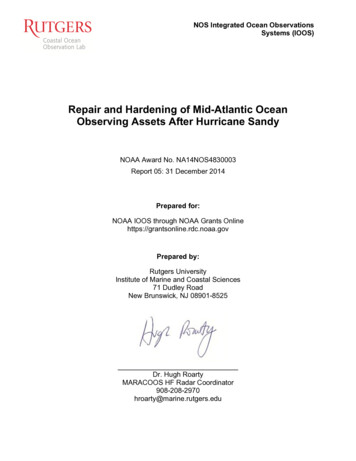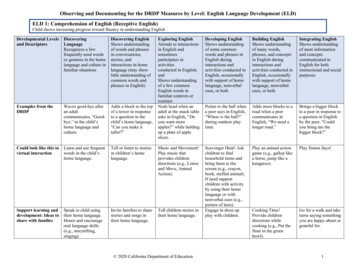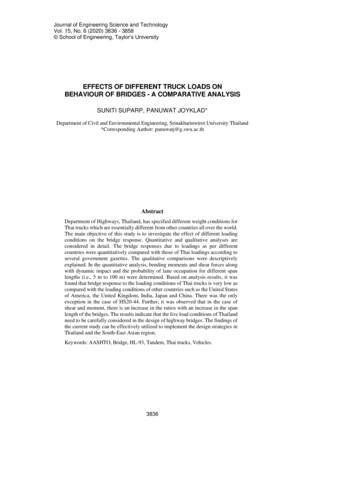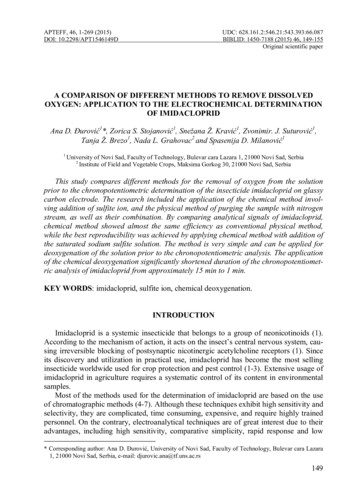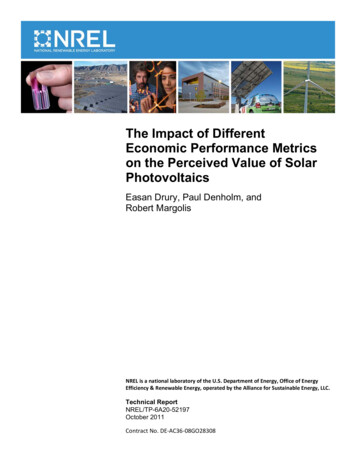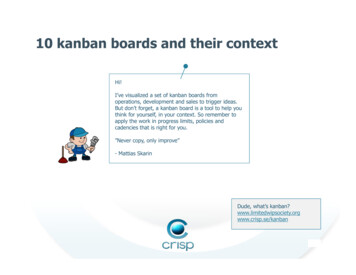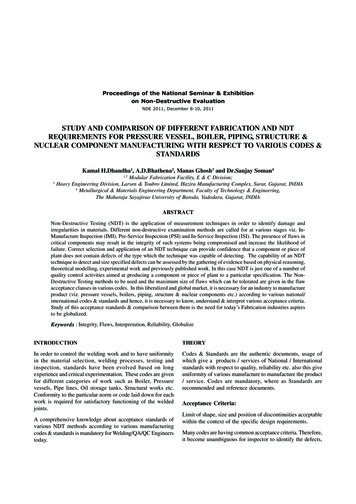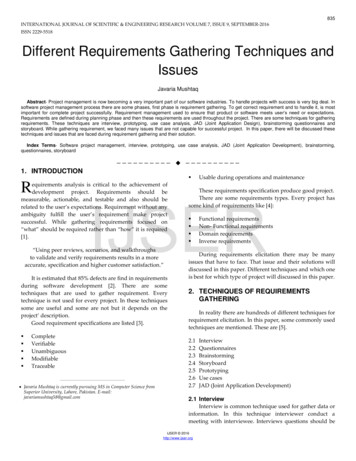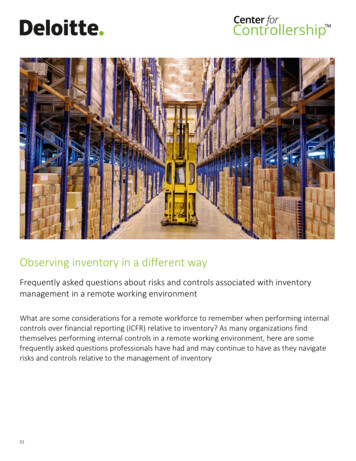
Transcription
Observing inventory in a different wayFrequently asked questions about risks and controls associated with inventorymanagement in a remote working environmentWhat are some considerations for a remote workforce to remember when performing internalcontrols over financial reporting (ICFR) relative to inventory? As many organizations findthemselves performing internal controls in a remote working environment, here are somefrequently asked questions professionals have had and may continue to have as they navigaterisks and controls relative to the management of inventory01
Risk Assessment and ComplianceWhat kind of considerations could influence alternate procedures for managing inventoryin situations where inventory counts cannot be conducted as initially planned due toimplications of COVID-19?A number of variations exist in inventory profiles. Risk assessments continue to be at the forefront of decisions relative to theappropriateness of financial reporting. Typically, the risk assessment process is iterative and should be facts- and circumstance-based.Risk considerations that may influence the procedures you perform over managing inventory records could include, but are not limitedto: The nature of the inventory.Whether you maintain a perpetual inventory system.Whether you need the assistance of a specialist to conduct inventory counts (and whether such specialists are able to provide thesame level of assistance in a changing environment).Whether the systems used to process inventory transactions are the same across multiple or all locations.Whether or not there has been a history of errors or deficiencies identified related to the inventory counts.The locations at which inventory is held (including the materiality of the inventory and risks at different locations).The significance of the risks related to inventory.Whether you have adequate procedures and instructions for physical inventory counting.The timing of physical inventory counting.The competence and objectivity, including independence, of all counters and reviewers involved in the inventory counts.The accuracy/coverage rates achieved by the inventory counts.The controls designed, implemented, and maintained related to inventory management.Whether the relevant processes and controls are common across multiple or all locations.The processes and procedures implemented by management to monitor inventory count results.Whether your external auditor is planning on relying on management’s inventory counts – if so, please work with yourexternal auditor.What challenges may exist from a SOX compliance perspective for management andexternal auditors?Controls guidance indicates that management is responsible for maintaining evidential matter, including documentation, to providesufficient evidential matter related to the operation of its internal controls (including controls related to inventory management). In aremote working environment, evidential matter supporting the execution of internal controls may change format. You, as well as yourexternal auditor, should consider preparing for any changes that may impact the sufficiency of the evidential matter utilized for SOXcompliance purposes. This includes the evidence maintained related to inventory counts conducted virtually or other alternateprocedures performed in lieu of traditional inventory counts.From management’s perspective, the current environment may result in the need to perform alternate procedures, and the evidenceneeded to support SOX compliance conclusions may come from a combination of different controls. From an external auditorperspective, standards may require the auditor to be present to observe inventory counts. The decision to use alternate processes andcontrols to obtain evidence over inventory management will likely require timely communication between management and yourexternal auditor as it relates to the appropriateness of using the work of others or potential use of video technology enablement inconducting inventory counts (see the Alternate Procedures and Use of Video Technology sections below for further consideration ofthese topics).02
Alternate ProceduresWhat might alternate procedures look like if the ability to conduct inventory counts hasbeen deemed impracticable or counts cannot be conducted as originally planned dueto COVID-19?Below are some general alternate procedures that may be effective in managing your inventory (this list is not intended to be allinclusive): 03Accelerate or defer the timing of planned counts to a different date. If counts are moved to a date that is before or after the balancesheet date, rollforward or rollback procedures may be required.In cases where a portion of inventory is no longer able to be counted at the initially planned frequency or extent, consider if applyinga statistically based sampling approach could provide appropriate evidence over the remaining inventory population such that a fullcount of all such items would not be necessary.In instances where a cycle-count program is utilized to manage inventory and counts have been performed throughout the year, butnot during Q4, consider if additional counts are needed during Q4. Consider if the inventory counts conducted throughout the yearprovide sufficient evidence when combined with the inventory management controls that have been in place throughout the period(see next bullet for controls). Additional counts in Q4 may not be deemed necessary (taking into account risk considerations fromthe Risk Assessment and Compliance section above). In such scenarios, consider if initial risk assessment conclusions related to theinventory management process are still applicable and whether a change in controls in the inventory management process isnecessary.In cases where conducting inventory counts has been deemed impracticable or counts could not be conducted as originally planned,consider whether other existing controls that are designed and operating effectively are in place to sufficiently address the risksrelated to inventory management. If such controls were not previously considered SOX controls, consider whether they could nowbe assessed as such. Example controls may include:‒ Accounts payable and corresponding inventory journal entries are recorded in the system upon matching the purchase order,receiving documents, and completed work order or vendor invoice. This matching may be performed automatically by thesystem or manually. Any exceptions to the three-way match are investigated and resolved prior to a journal entry beingrecorded.‒ On a monthly basis, management reviews the reconciliation of third-party inventory reports to the entity's inventory records.Reconciling items, if any, are investigated and addressed in a timely manner.‒ On a monthly basis, management reviews the reconciliation between the inventory subledger and the general ledger.Reconciling items, if any, are investigated and addressed in a timely manner.‒ Cost of sales is recorded, and inventory is relieved only upon matching the customer order (purchase order), shippingdocuments, and the invoice generated, completing a three-way match. This matching may be performed automatically by thesystem or manually. Any exceptions to the three-way match are investigated and resolved prior to a journal entry beingrecorded.‒ Count controls that had previously served as a supplement to SOX count controls (e.g., instances where a third-party counterwas traditionally used to perform the SOX count control, but management also has store/warehouse employees do counts, or afull physical count has historically been completed as the SOX control, but management also performs cycle counts).If possible, consider using competent, independent, and objective alternate personnel to perform the inventory counts if thepersonnel typically involved in the inventory counts are now working remotely. This also includes evaluating changes to policies andprocedures relative to this person’s role and ensuring continued segregation of duties related to the counting process. For example,we have observed management leverage internal resources with inventory count knowledge from other functions, or a third-partystaff augmentation model.
If inventory is maintained at third party warehouses, consider performing the following:‒ Ask the third party about any changes to processes and controls.‒ Evaluate the impact of any changes on the reliability of the confirmation from the third-party warehouse as to the quantities andcondition of inventory.‒ Obtain a service organization’s SOC-1 report, if available. If your external auditor plans on relying on management’s testing procedures, coordinate with your external auditor accordingly.Alternate ResourceWe keep hearing the terms ‘independent’ and ‘objective’ as it relates to the personnelperforming our remote counting procedures. What could this look like and mean inpractice?The terms ‘independent’ and ‘objective’ are relevant in multiple aspects of conducting inventory counts in a remote workingenvironment. Despite the unique working conditions, all warehouse personnel / counters should maintain appropriate segregation ofduties to conduct effective inventory counts (e.g., segregation between the initial counter, recounter (if needed), reviewer of countresults, and recorder of any necessary adjustments). In addition, personnel / counters may be taking on new roles within the countingprocess. In such cases, management should evaluate whether the counters have the appropriate level of knowledge / competence toperform these new roles.04
Use of Video TechnologyWhat should we consider if we’d like to use video technology while performing our cycleand/or full physical inventory counts (and related SOX controls) remotely? Is there any‘How-To’ guidance on performing counts remotely via video technology? Can we designatesomeone at the warehouse to direct the count on our behalf?Below is a list of items management may want to consider in an environment where inventory counts are performed remotelyusing video technology: Is there a reliable video technology available to facilitate communication and a virtual count?Is someone independent of the inventory management team able to operate the video technology being used at your direction forthe duration of the count?Is the nature of the inventory such that is it easily distinguishable and able to be identified via video technology (e.g., inventory tagsor other unique identifiers)?How will we confirm that production and shipping/receiving have been shut down for the duration of the count (e.g., has the personoperating the video technology shown you there is no activity on the shipping/loading dock at the time of count; reviewing shippingand receiving logs to confirm there was no activity during the count)?How will appropriate segregation of duties be maintained throughout the count process from those performing the countingthrough those reviewing results and posting any necessary adjusting journal entries?How will you ensure the person operating the video technology has shown you the entire warehouse (i.e., there isn’t excess orobsolete inventory out of sight of the camera)?Is your external auditor planning on relying on management’s inventory counts? If so, coordinate with them timely and ensure theprocedures are sufficient for their purposes.Further, consider including someone outside of the traditional inventory management team on-site when a remote count is conductedto serve as your delegate in coordinating count procedures and to also be the person who will operate the video technology to conductthe remote count. This person can provide you with an unbiased representative to make sure the count is conducted in accordance withyour direction. The independent delegate is able to assist you in conducting necessary count steps (e.g., walk through of the warehouse,confirmation of inventory SKUs/tags, validation of no excess or obsolete inventory, etc.) in an impartial manner.05
ContactsJulie VelayoPatty SalkinMichelle DonahuePrincipalManaging DirectorAudit & Assurance Managing DirectorDeloitte Risk & Financial AdvisoryDeloitte Risk & Financial AdvisoryNational Office – Audit & Assurance ServicesDeloitte & Touche LLPDeloitte & Touche LLPDeloitte & Touche onahue@deloitte.com 1 704 227 1425 1 609 806 7279 1 203 563 2556Stefan OzerZak FullertonAudit & Assurance Senior ManagerAudit & Assurance ManagerDeloitte & Touche LLPDeloitte & Touche LLPsozer@deloitte.comzfullerton@deloitte.com 1 763 670 7797 1 612 360 9219As used in this document, “Deloitte” means Deloitte & Touche LLP, a subsidiary of Deloitte LLP. Please see www.deloitte.com/us/about for adetailed description of our legal structure. Certain services may not be available to attest clients under the rules and regulations of publicaccounting.This publication contains general information only and Deloitte is not, by means of this publication, rendering accounting, business, financial,investment, legal, tax, or other professional advice or services. This publication is not a substitute for such professional advice or services, norshould it be used as a basis for any decision or action that may affect your business. Before making any decision or taking any action that mayaffect your business, you should consult a qualified professional advisor. Deloitte shall not be responsible for any loss sustained by any person whorelies on this publication.Copyright 2020 Deloitte Development LLC. All rights reserved.06
needed to support SOX compliance conclusions may come from a combination of different controls. From an external auditor perspective, standards may require the auditor to be present to observe inve
